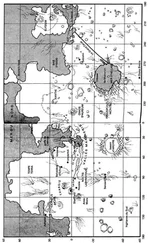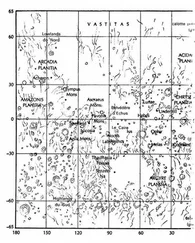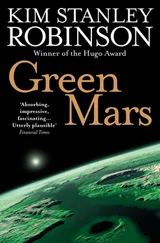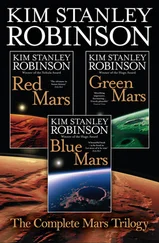A call from the Chernobyl crew interrupted her bulldozing. “Nadia, how can we get cement this thick to set in the cold?”
“Heat it.”
“We are!”
“Heat it more.”
“Oh!” They were almost done out there, Nadia judged; the Rickover had been mostly preassembled, it was a matter of putting the forms together, fitting in the steel containment tank, filling the pipes with water (which dropped their supply to nearly nothing), wiring it all up, piling sandbags around it all, and pulling the control rods. After that they would have 300 kilowatts on hand, which would put an end to the nightly argument over who got the lion’s share of generator power the next day.
There was a call from Sax. One of the Sabatier processors had clogged, and they couldn’t get the housing off it. So Nadia left the bulldozing to John and Maya, and took a rover to the factory complex to have a look. “I’m off to see the alchemists,” she said.
“Have you ever noticed how much the machinery here reflects the character of the industry that built it?” Sax remarked to Nadia as she arrived and went to work on the Sabatier. “If it was built by car companies, it’s low-powered but reliable. If it was built by the aerospace industry, it’s outrageously high-powered but breaks down twice a day.”
“And partnership products are horribly designed,” Nadia said.
“Right.”
“And chemical equipment is finicky,” Spencer Jackson added.
“I’ll say. Especially in this dust.”
The Boeing air miners had been only the start of the factory complex; their gases were fed into big boxy trailers to be compressed and expanded and rendered and recombined, using chemical-engineering operations such as dehumidification, liquefaction, fractional distillation, electrolysis, electrosynthesis, the Sabatier process, the Raschig process, the Oswald process. . Slowly they worked up more and more complex chemicals, which flowed from one factory to the next, through a warren of structures that looked like mobile homes caught in a web of color-coded tanks and pipes and tubes and cables.
Spencer’s current favorite product was magnesium, which was plentiful; they were getting twenty-five kilos of it from every cubic meter of regolith, he said, and it was so light in Martian g that a big bar of it felt like a piece of plastic. “It’s too brittle when pure,” Spencer said, “but if we alloy it just a bit we’ll have an extremely light and strong metal.”
“Martian steel,” Nadia said.
“Better than that.”
So, alchemy; but with finicky machines. Nadia found the Sabatier’s problem, and went to work fixing a broken vacuum pump. It was amazing how much of the factory complex came down to pumps, sometimes it seemed nothing but a mad assemblage of them, and by their nature they kept clogging with fines and breaking down.
Two hours later the Sabatier was fixed. On the way back to the trailer park, Nadia glanced into the first greenhouse. Plants were already blooming, the new crops breaking out of their beds of new black soil. Green glowed intensely in the reds of this world, it was a pleasure to see it. The bamboo was growing several centimeters a day, she had been told, and the crop was already nearly five meters tall. It was easy to see they were going to need more soil. Back at the alchemists’ they were using nitrogen from the Boeings to synthesize ammonia fertilizers; Hiroko craved these because the regolith was an agricultural nightmare, intensely salty, explosive with peroxides, extremely arid, and completely without biomass. They were going to have to construct soil just like they had the magnesium bars.
Nadia went into her habitat in the trailer park for a standing lunch. Then she was out again, to the site of the permanent habitat. The floor of the trench had been almost leveled in her absence. She stood on the edge of the hole, looking down in it. They were going to build to a design that she liked tremendously, one she had worked on herself in Antarctica and on the Ares : a simple line of barrel-vaulted chambers, sharing adjacent walls. By setting them in the trench the chambers would be half-buried to begin with; then when completed they would be covered by ten meters of sandbagged regolith, to stop radiation and also, because they planned to pressurize to 450 millibars, to keep the buildings from exploding. Local materials were all they needed for the exteriors of these buildings: Portland cement and bricks were it, basically, with plastic liner in some places to insure the seal.
Unfortunately the brickmakers were having some trouble, and they gave Nadia a call. Nadia’s patience was running short, and she groaned. “We travel all the way to Mars and you can’t make bricks?”
“It’s not that we can’t make bricks,” said Gene. “It’s just that I don’t like them.” The brickmaking factory mixed clays and sulphur extracted from the regolith, and this preparation was poured into brick molds, and baked until the sulphur began to polymerize, and then as the bricks cooled they were compressed a bit in another part of the machine. The resulting blackish-red bricks had a tensile strength that was technically adequate for use in the barrel vaults, but Gene wasn’t happy. “We don’t want to be at minimum values for heavy roofs over our heads,” he said. “What if we pile one too many sandbag on top of it, or if we get a little marsquake? I don’t like it.”
After some thought Nadia said, “Add nylon.”
“What?”
“Go out and find the parachutes from the freight drops, and shred them real fine, and add them to the clay. That’ll help their tensile strength.”
“Very true,” Gene said, after a pause. “Good idea! Think we can find the parachutes?”
“They must be east of here somewhere.”
So they had finally found a job for the geologists that actually helped the construction effort. Ann and Simon and Phyllis and Sasha and Igor drove long-distance rovers over the horizon to east of the base, searching and surveying far past Chernobyl, and in the next week they found almost forty parachutes, each one representing a few hundred kilos of useful nylon.
One day they came back excited, having reached Ganges Catena, a series of sinkholes in the plain a hundred kilometers to the southeast. “It was strange,” Igor said, “because you can’t see them until the last minute, and then they’re like huge funnels, about ten kilometers across and a couple deep, eight or nine in a row, each smaller and shallower. Fantastic. They’re probably thermokarsts, but they’re so big it’s hard to believe it.”
Sasha said, “It’s nice to see such a distance, after all this near horizon stuff.”
“They’re thermokarsts,” Ann said. But they had drilled and found no water. This was getting to be a concern; they hadn’t found any water to speak of in the ground, no matter how far down they drilled. It forced them to rely on the supplies from the air miners.
Nadia shrugged. The air miners were pretty tough. She wanted to think about her vaults. The new improved bricks were appearing, and she had started the robots building the walls and roofs. The brick factory filled little robot cars, which rolled like toy rovers across the plain to cranes at the site; the cranes pulled out bricks one by one, and placed them on cold mortar spread by another set of robots. The system worked so well that soon the bottleneck became brick production itself. Nadia would have been pleased, if she had had more faith in the robots. These seemed okay, but her experiences with robots in the years on Novy Mir had made her wary. They were great if everything went perfectly, but nothing ever went perfectly, and it was hard to program them with decision algorithms that didn’t either make them so cautious that they froze every minute, or so uncontrolled that they could commit unbelievable acts of stupidity, repeating an error a thousand times and magnifying a small glitch into a giant blunder, as in Maya’s emotional life. You got what you put into robots, but even the best were mindless idiots.
Читать дальше
Конец ознакомительного отрывка
Купить книгу












